Psychology Assignment: Persuasion Theories and Applications
VerifiedAdded on 2022/09/14
|10
|2577
|26
Essay
AI Summary
This essay provides a detailed exploration of four key persuasion theories: stimulus-response, inoculation theory, cognitive dissonance, and the boomerang effect. The essay begins by defining each theory, outlining its core principles, and discussing its strengths and weaknesses. It delves into the practical applications of these theories, offering real-world examples of how they are used to influence behavior and attitudes. A significant portion of the essay is dedicated to comparing and contrasting these theories, highlighting their similarities and differences in approach and effectiveness. Furthermore, the author reflects on personal experiences, providing examples of how these theories have been observed in action. Finally, the essay concludes by outlining how the author intends to utilize these theories in future persuasive endeavors, offering specific scenarios and strategies for their application. The essay demonstrates a strong understanding of the theoretical concepts and the ability to apply them critically.
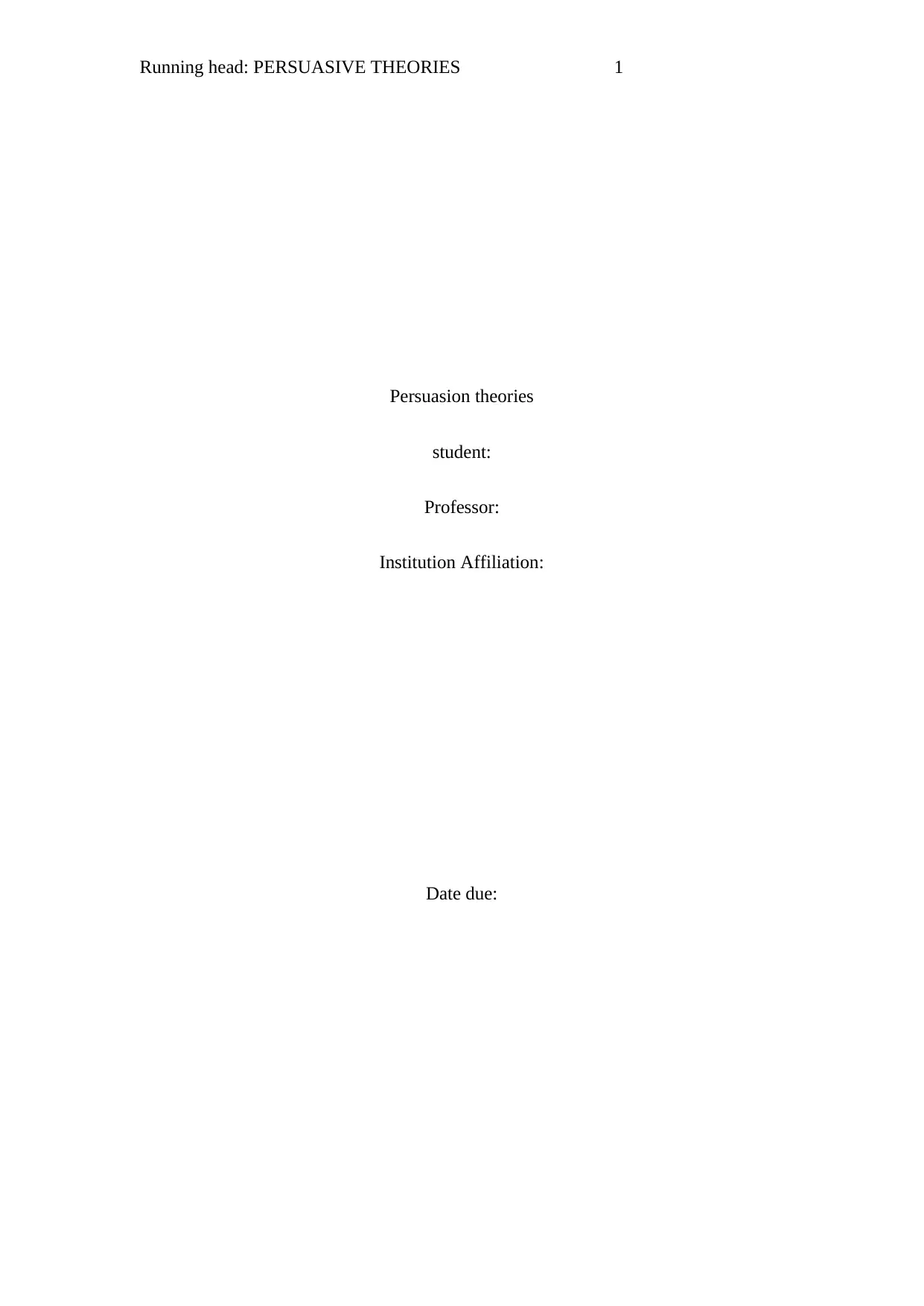
Running head: PERSUASIVE THEORIES 1
Persuasion theories
student:
Professor:
Institution Affiliation:
Date due:
Persuasion theories
student:
Professor:
Institution Affiliation:
Date due:
Paraphrase This Document
Need a fresh take? Get an instant paraphrase of this document with our AI Paraphraser
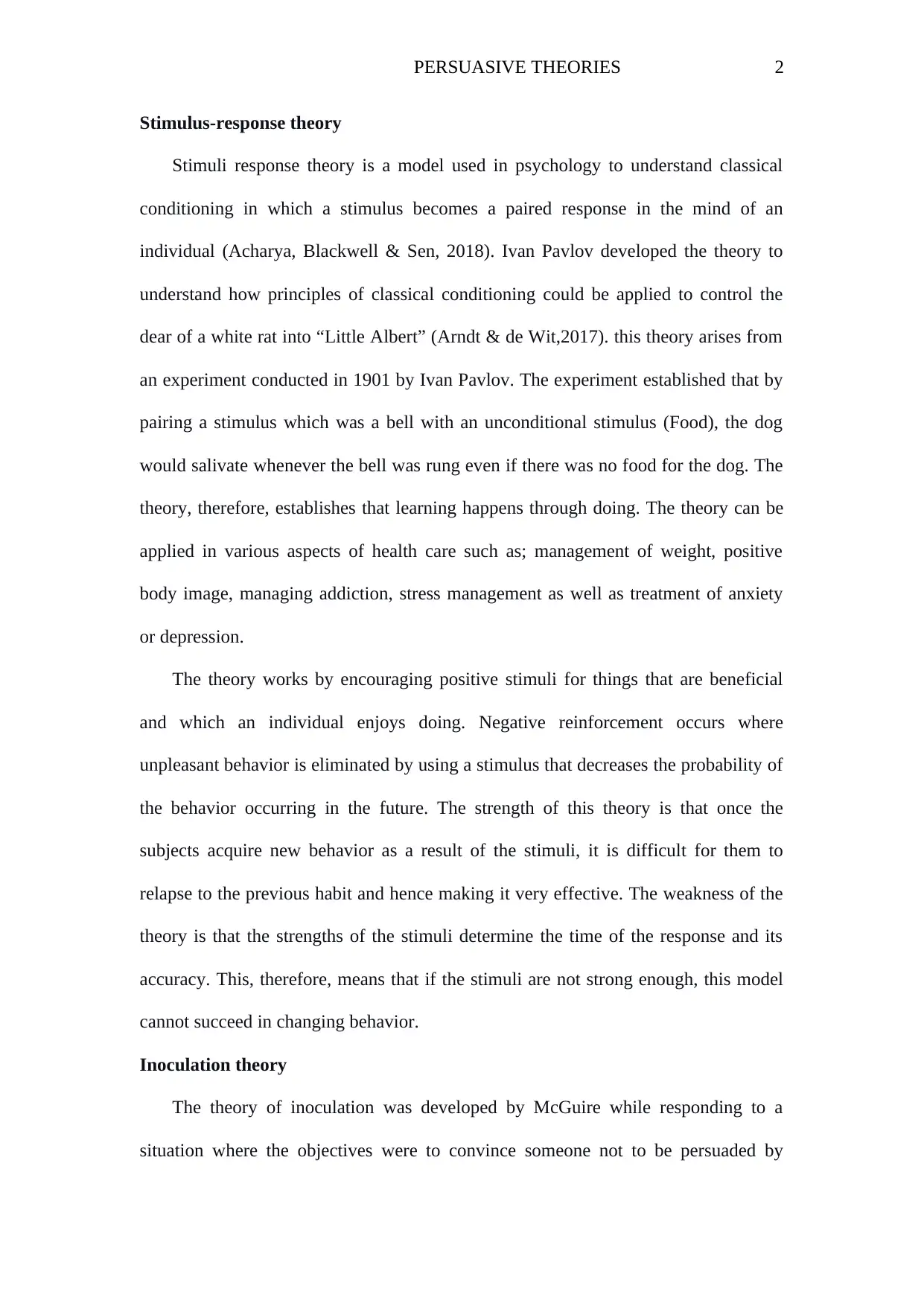
PERSUASIVE THEORIES 2
Stimulus-response theory
Stimuli response theory is a model used in psychology to understand classical
conditioning in which a stimulus becomes a paired response in the mind of an
individual (Acharya, Blackwell & Sen, 2018). Ivan Pavlov developed the theory to
understand how principles of classical conditioning could be applied to control the
dear of a white rat into “Little Albert” (Arndt & de Wit,2017). this theory arises from
an experiment conducted in 1901 by Ivan Pavlov. The experiment established that by
pairing a stimulus which was a bell with an unconditional stimulus (Food), the dog
would salivate whenever the bell was rung even if there was no food for the dog. The
theory, therefore, establishes that learning happens through doing. The theory can be
applied in various aspects of health care such as; management of weight, positive
body image, managing addiction, stress management as well as treatment of anxiety
or depression.
The theory works by encouraging positive stimuli for things that are beneficial
and which an individual enjoys doing. Negative reinforcement occurs where
unpleasant behavior is eliminated by using a stimulus that decreases the probability of
the behavior occurring in the future. The strength of this theory is that once the
subjects acquire new behavior as a result of the stimuli, it is difficult for them to
relapse to the previous habit and hence making it very effective. The weakness of the
theory is that the strengths of the stimuli determine the time of the response and its
accuracy. This, therefore, means that if the stimuli are not strong enough, this model
cannot succeed in changing behavior.
Inoculation theory
The theory of inoculation was developed by McGuire while responding to a
situation where the objectives were to convince someone not to be persuaded by
Stimulus-response theory
Stimuli response theory is a model used in psychology to understand classical
conditioning in which a stimulus becomes a paired response in the mind of an
individual (Acharya, Blackwell & Sen, 2018). Ivan Pavlov developed the theory to
understand how principles of classical conditioning could be applied to control the
dear of a white rat into “Little Albert” (Arndt & de Wit,2017). this theory arises from
an experiment conducted in 1901 by Ivan Pavlov. The experiment established that by
pairing a stimulus which was a bell with an unconditional stimulus (Food), the dog
would salivate whenever the bell was rung even if there was no food for the dog. The
theory, therefore, establishes that learning happens through doing. The theory can be
applied in various aspects of health care such as; management of weight, positive
body image, managing addiction, stress management as well as treatment of anxiety
or depression.
The theory works by encouraging positive stimuli for things that are beneficial
and which an individual enjoys doing. Negative reinforcement occurs where
unpleasant behavior is eliminated by using a stimulus that decreases the probability of
the behavior occurring in the future. The strength of this theory is that once the
subjects acquire new behavior as a result of the stimuli, it is difficult for them to
relapse to the previous habit and hence making it very effective. The weakness of the
theory is that the strengths of the stimuli determine the time of the response and its
accuracy. This, therefore, means that if the stimuli are not strong enough, this model
cannot succeed in changing behavior.
Inoculation theory
The theory of inoculation was developed by McGuire while responding to a
situation where the objectives were to convince someone not to be persuaded by

PERSUASIVE THEORIES 3
another person. The theory focuses on attempts to build resistance against persuasion
attempts by another person (Compton & Craig, 2019). The subject is exposed to
arguments against their beliefs, and then counter-arguments against the previous
arguments are made to refute the initial attempts of persuasion. The model provides a
method of communication that people can use to defend their beliefs and ideas. One
of the two components of the theory is a threat. A threat is where a prior warning is
issued about a potential attack on a personal attitude and beliefs (Compton, Jackson &
Dimmock, 2016). This, therefore, motivates a person to defend their beliefs. The other
aspect is the reputational preemption. This involves telling the subjects what the
attack on their beliefs will be about and hence enabling the individual to prepare
counter-arguments. The theory has been used in convincing teenagers to stop binge
drinking as well as smoking (Compton et al., 2019). It has also been successfully used
to discourage drink driving.
The strength of this theory is that it is practical and elicit a defensive mindset
within a person and hence cementing the values and beliefs that a person has towards
a particular behavior. If it is a negative behavior or habit, a person, therefore, tries to
prove that they are not the way people view them and hence challenging them to be
better. The weakness of this approach is that it becomes ineffective if a person does
not react to the original attack (Ivanov, 2017). The technique cannot work if a person
has negative beliefs on a particular subject.
Cognitive dissonance theory
Leon Festinger proposed the cognitive dissonance theory. Leon studies a cult
which believed that the earth was going to be destroyed by floods, and hence many of
them sold their properties, and others left their jobs to spread the message of the cult
(Harmon-Jones & Mills, 2019). He, therefore, observed the behavior of the members
another person. The theory focuses on attempts to build resistance against persuasion
attempts by another person (Compton & Craig, 2019). The subject is exposed to
arguments against their beliefs, and then counter-arguments against the previous
arguments are made to refute the initial attempts of persuasion. The model provides a
method of communication that people can use to defend their beliefs and ideas. One
of the two components of the theory is a threat. A threat is where a prior warning is
issued about a potential attack on a personal attitude and beliefs (Compton, Jackson &
Dimmock, 2016). This, therefore, motivates a person to defend their beliefs. The other
aspect is the reputational preemption. This involves telling the subjects what the
attack on their beliefs will be about and hence enabling the individual to prepare
counter-arguments. The theory has been used in convincing teenagers to stop binge
drinking as well as smoking (Compton et al., 2019). It has also been successfully used
to discourage drink driving.
The strength of this theory is that it is practical and elicit a defensive mindset
within a person and hence cementing the values and beliefs that a person has towards
a particular behavior. If it is a negative behavior or habit, a person, therefore, tries to
prove that they are not the way people view them and hence challenging them to be
better. The weakness of this approach is that it becomes ineffective if a person does
not react to the original attack (Ivanov, 2017). The technique cannot work if a person
has negative beliefs on a particular subject.
Cognitive dissonance theory
Leon Festinger proposed the cognitive dissonance theory. Leon studies a cult
which believed that the earth was going to be destroyed by floods, and hence many of
them sold their properties, and others left their jobs to spread the message of the cult
(Harmon-Jones & Mills, 2019). He, therefore, observed the behavior of the members
⊘ This is a preview!⊘
Do you want full access?
Subscribe today to unlock all pages.

Trusted by 1+ million students worldwide

PERSUASIVE THEORIES 4
after their prophecy failed. He noticed that the members who were not so much into
the cult recognized that they were fooled while those who were deeply into the cult
defended their beliefs and said that their faith prevented the world from being
destroyed. The theory, therefore, suggests that human beings have an inner drive to
hold their behavior and attitudes in harmony, and they do everything to avoid
disharmony (Nakamura, Suhrcke & Zizzo, 2017). This model is used in healthcare to
educate people and help them change their behavior. For example, when encouraging
a person to exercise and cut their weight, they face dissonance between doing the
exercises and becoming healthier, or they stay comfortable and avoid the strain of the
exercise, and they remain unhealthy. The person, therefore, has to spread the
alternatives, and hence they are more likely to choose to do the exercises.
The strength of this theory is that it provides a person with new information,
which increases dissonance and hence discouraging a person from doing a certain
thing. The weakness of this theory is that it is difficult to change the behavior which
has been enhanced over time, such as smoking. This, therefore, limits the applicability
of this theory. The other weakness is that a person might reduce the importance of
their beliefs, and hence the theory might not be effective (Hinojosa et al., 2017).
Boomerang effect
Boomerang effect is the unintended consequences resulting from an effort to
persuade and hence resulting in a person adopting the opposite of what was intended
(Cannon & Byrne, 2019). This theory is based on the assumption that any attempt to
restrict the freedom of behavior of a person is met with anti-conformity/resistance.
When an individual reacts contrary to what was expected, it, therefore, means that the
attempt to change the behavior or beliefs of that person fails. The weakness of the
after their prophecy failed. He noticed that the members who were not so much into
the cult recognized that they were fooled while those who were deeply into the cult
defended their beliefs and said that their faith prevented the world from being
destroyed. The theory, therefore, suggests that human beings have an inner drive to
hold their behavior and attitudes in harmony, and they do everything to avoid
disharmony (Nakamura, Suhrcke & Zizzo, 2017). This model is used in healthcare to
educate people and help them change their behavior. For example, when encouraging
a person to exercise and cut their weight, they face dissonance between doing the
exercises and becoming healthier, or they stay comfortable and avoid the strain of the
exercise, and they remain unhealthy. The person, therefore, has to spread the
alternatives, and hence they are more likely to choose to do the exercises.
The strength of this theory is that it provides a person with new information,
which increases dissonance and hence discouraging a person from doing a certain
thing. The weakness of this theory is that it is difficult to change the behavior which
has been enhanced over time, such as smoking. This, therefore, limits the applicability
of this theory. The other weakness is that a person might reduce the importance of
their beliefs, and hence the theory might not be effective (Hinojosa et al., 2017).
Boomerang effect
Boomerang effect is the unintended consequences resulting from an effort to
persuade and hence resulting in a person adopting the opposite of what was intended
(Cannon & Byrne, 2019). This theory is based on the assumption that any attempt to
restrict the freedom of behavior of a person is met with anti-conformity/resistance.
When an individual reacts contrary to what was expected, it, therefore, means that the
attempt to change the behavior or beliefs of that person fails. The weakness of the
Paraphrase This Document
Need a fresh take? Get an instant paraphrase of this document with our AI Paraphraser

PERSUASIVE THEORIES 5
boomerang effect is that it might result in worsening of a condition that was intended
to be corrected, and hence by health promotion efforts becomes counterproductive.
Compare and contrast the theories
The stimuli response theory and the inoculation theory is that both theories use
some “bait” to motivate the subject. The stimuli response theory uses a stimulus that
is attractive to a person to influence a change of behavior, and the inoculation theory
also uses an incentive to motivate a person to react (Ong, Frewer & Chan, 2017). The
difference between the two theories is that the stimuli response theory uses positive
motivation. In contrast, the inoculation theory introduces a negative aspect so that a
person can react against it. The other difference between these two theories is that the
stimuli response theory takes a lot of time to persuade a person, while the inoculation
theory requires little time.
The cognitive dissonance model and the boomerang effect are very similar. In
both theories, people do something despite their beliefs being the opposite of what
they are practicing. The difference between the theories is that for cognitive
dissonance theory an individual reconciles the differences between what they are
doing and what they believe while for boomerang effect, a person goes against what
they are told is wrong irrespective of their belief in regard to the specific subject
(Choi & Lee, 2016).
The cognitive dissonance theory and the inoculation theory are similar in that
both theories involve an individual defending their beliefs, whether they are wrong or
right. The difference between the theories is that the cognitive dissonance theory
seeks to persuade by reconciling the difference between ideas and actions. In contrast,
the inoculation theory works by defending the positive beliefs that a person has, so
has to avoid negative influence (Shimazaki et al., 2018).
boomerang effect is that it might result in worsening of a condition that was intended
to be corrected, and hence by health promotion efforts becomes counterproductive.
Compare and contrast the theories
The stimuli response theory and the inoculation theory is that both theories use
some “bait” to motivate the subject. The stimuli response theory uses a stimulus that
is attractive to a person to influence a change of behavior, and the inoculation theory
also uses an incentive to motivate a person to react (Ong, Frewer & Chan, 2017). The
difference between the two theories is that the stimuli response theory uses positive
motivation. In contrast, the inoculation theory introduces a negative aspect so that a
person can react against it. The other difference between these two theories is that the
stimuli response theory takes a lot of time to persuade a person, while the inoculation
theory requires little time.
The cognitive dissonance model and the boomerang effect are very similar. In
both theories, people do something despite their beliefs being the opposite of what
they are practicing. The difference between the theories is that for cognitive
dissonance theory an individual reconciles the differences between what they are
doing and what they believe while for boomerang effect, a person goes against what
they are told is wrong irrespective of their belief in regard to the specific subject
(Choi & Lee, 2016).
The cognitive dissonance theory and the inoculation theory are similar in that
both theories involve an individual defending their beliefs, whether they are wrong or
right. The difference between the theories is that the cognitive dissonance theory
seeks to persuade by reconciling the difference between ideas and actions. In contrast,
the inoculation theory works by defending the positive beliefs that a person has, so
has to avoid negative influence (Shimazaki et al., 2018).
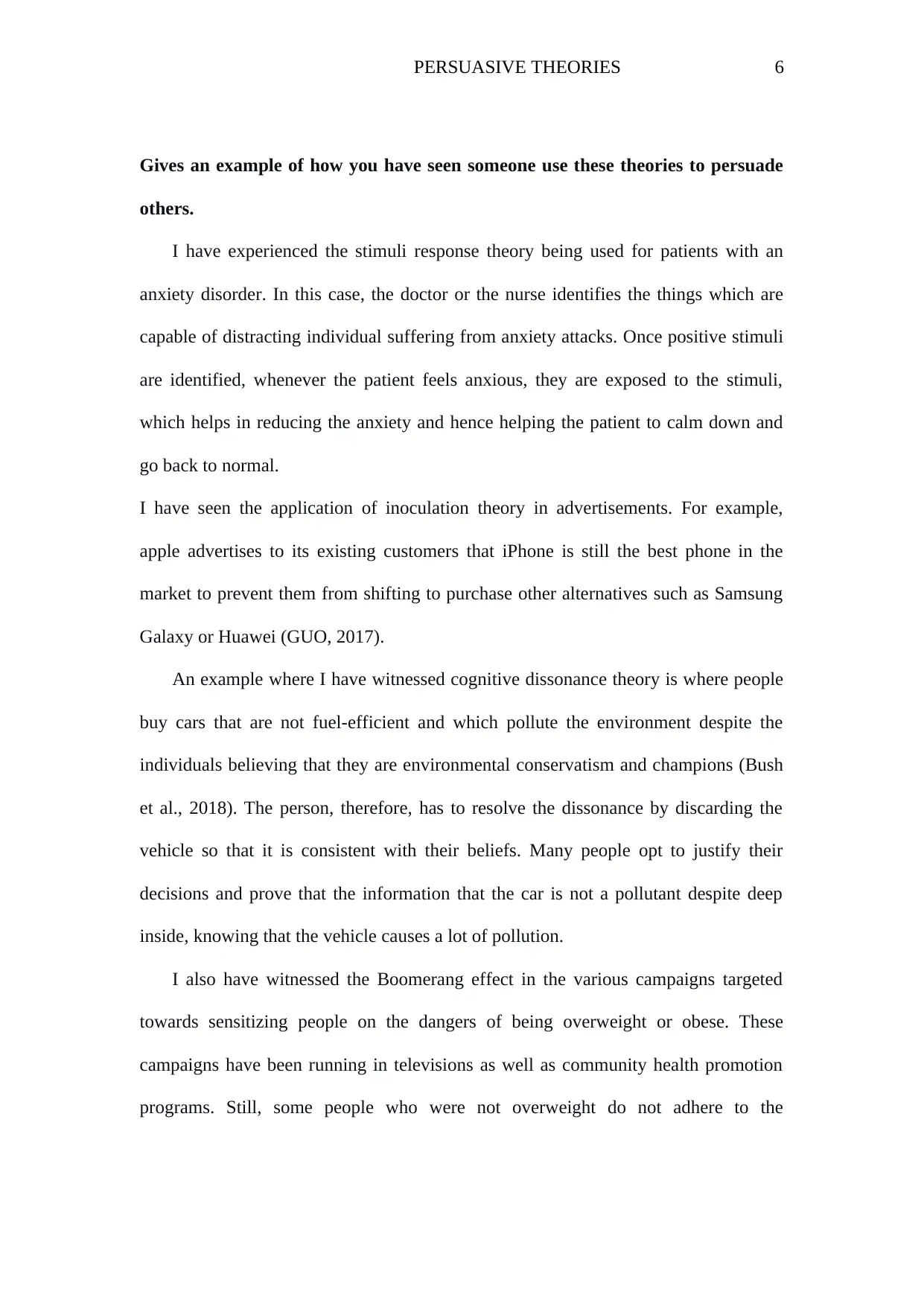
PERSUASIVE THEORIES 6
Gives an example of how you have seen someone use these theories to persuade
others.
I have experienced the stimuli response theory being used for patients with an
anxiety disorder. In this case, the doctor or the nurse identifies the things which are
capable of distracting individual suffering from anxiety attacks. Once positive stimuli
are identified, whenever the patient feels anxious, they are exposed to the stimuli,
which helps in reducing the anxiety and hence helping the patient to calm down and
go back to normal.
I have seen the application of inoculation theory in advertisements. For example,
apple advertises to its existing customers that iPhone is still the best phone in the
market to prevent them from shifting to purchase other alternatives such as Samsung
Galaxy or Huawei (GUO, 2017).
An example where I have witnessed cognitive dissonance theory is where people
buy cars that are not fuel-efficient and which pollute the environment despite the
individuals believing that they are environmental conservatism and champions (Bush
et al., 2018). The person, therefore, has to resolve the dissonance by discarding the
vehicle so that it is consistent with their beliefs. Many people opt to justify their
decisions and prove that the information that the car is not a pollutant despite deep
inside, knowing that the vehicle causes a lot of pollution.
I also have witnessed the Boomerang effect in the various campaigns targeted
towards sensitizing people on the dangers of being overweight or obese. These
campaigns have been running in televisions as well as community health promotion
programs. Still, some people who were not overweight do not adhere to the
Gives an example of how you have seen someone use these theories to persuade
others.
I have experienced the stimuli response theory being used for patients with an
anxiety disorder. In this case, the doctor or the nurse identifies the things which are
capable of distracting individual suffering from anxiety attacks. Once positive stimuli
are identified, whenever the patient feels anxious, they are exposed to the stimuli,
which helps in reducing the anxiety and hence helping the patient to calm down and
go back to normal.
I have seen the application of inoculation theory in advertisements. For example,
apple advertises to its existing customers that iPhone is still the best phone in the
market to prevent them from shifting to purchase other alternatives such as Samsung
Galaxy or Huawei (GUO, 2017).
An example where I have witnessed cognitive dissonance theory is where people
buy cars that are not fuel-efficient and which pollute the environment despite the
individuals believing that they are environmental conservatism and champions (Bush
et al., 2018). The person, therefore, has to resolve the dissonance by discarding the
vehicle so that it is consistent with their beliefs. Many people opt to justify their
decisions and prove that the information that the car is not a pollutant despite deep
inside, knowing that the vehicle causes a lot of pollution.
I also have witnessed the Boomerang effect in the various campaigns targeted
towards sensitizing people on the dangers of being overweight or obese. These
campaigns have been running in televisions as well as community health promotion
programs. Still, some people who were not overweight do not adhere to the
⊘ This is a preview!⊘
Do you want full access?
Subscribe today to unlock all pages.

Trusted by 1+ million students worldwide
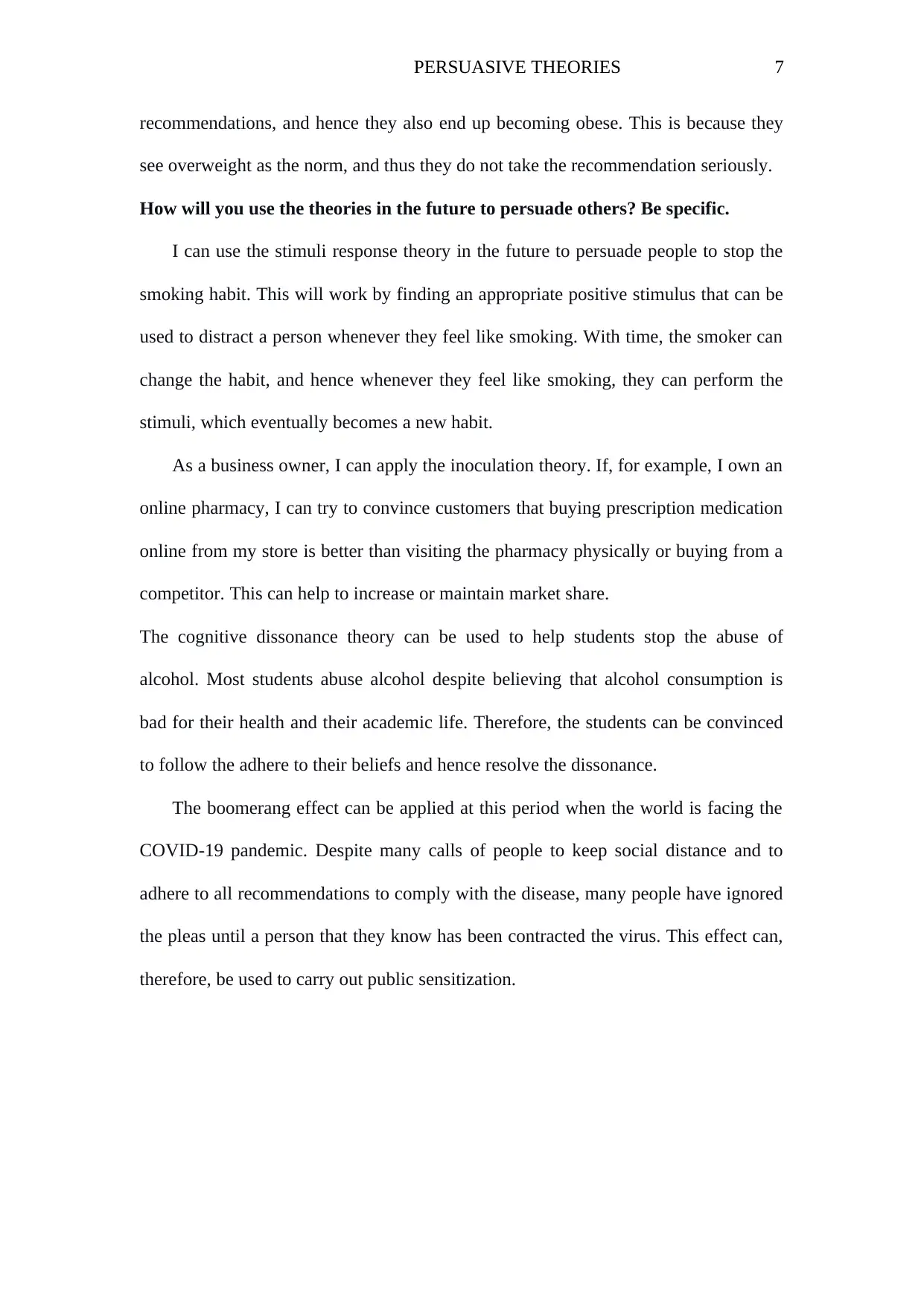
PERSUASIVE THEORIES 7
recommendations, and hence they also end up becoming obese. This is because they
see overweight as the norm, and thus they do not take the recommendation seriously.
How will you use the theories in the future to persuade others? Be specific.
I can use the stimuli response theory in the future to persuade people to stop the
smoking habit. This will work by finding an appropriate positive stimulus that can be
used to distract a person whenever they feel like smoking. With time, the smoker can
change the habit, and hence whenever they feel like smoking, they can perform the
stimuli, which eventually becomes a new habit.
As a business owner, I can apply the inoculation theory. If, for example, I own an
online pharmacy, I can try to convince customers that buying prescription medication
online from my store is better than visiting the pharmacy physically or buying from a
competitor. This can help to increase or maintain market share.
The cognitive dissonance theory can be used to help students stop the abuse of
alcohol. Most students abuse alcohol despite believing that alcohol consumption is
bad for their health and their academic life. Therefore, the students can be convinced
to follow the adhere to their beliefs and hence resolve the dissonance.
The boomerang effect can be applied at this period when the world is facing the
COVID-19 pandemic. Despite many calls of people to keep social distance and to
adhere to all recommendations to comply with the disease, many people have ignored
the pleas until a person that they know has been contracted the virus. This effect can,
therefore, be used to carry out public sensitization.
recommendations, and hence they also end up becoming obese. This is because they
see overweight as the norm, and thus they do not take the recommendation seriously.
How will you use the theories in the future to persuade others? Be specific.
I can use the stimuli response theory in the future to persuade people to stop the
smoking habit. This will work by finding an appropriate positive stimulus that can be
used to distract a person whenever they feel like smoking. With time, the smoker can
change the habit, and hence whenever they feel like smoking, they can perform the
stimuli, which eventually becomes a new habit.
As a business owner, I can apply the inoculation theory. If, for example, I own an
online pharmacy, I can try to convince customers that buying prescription medication
online from my store is better than visiting the pharmacy physically or buying from a
competitor. This can help to increase or maintain market share.
The cognitive dissonance theory can be used to help students stop the abuse of
alcohol. Most students abuse alcohol despite believing that alcohol consumption is
bad for their health and their academic life. Therefore, the students can be convinced
to follow the adhere to their beliefs and hence resolve the dissonance.
The boomerang effect can be applied at this period when the world is facing the
COVID-19 pandemic. Despite many calls of people to keep social distance and to
adhere to all recommendations to comply with the disease, many people have ignored
the pleas until a person that they know has been contracted the virus. This effect can,
therefore, be used to carry out public sensitization.
Paraphrase This Document
Need a fresh take? Get an instant paraphrase of this document with our AI Paraphraser
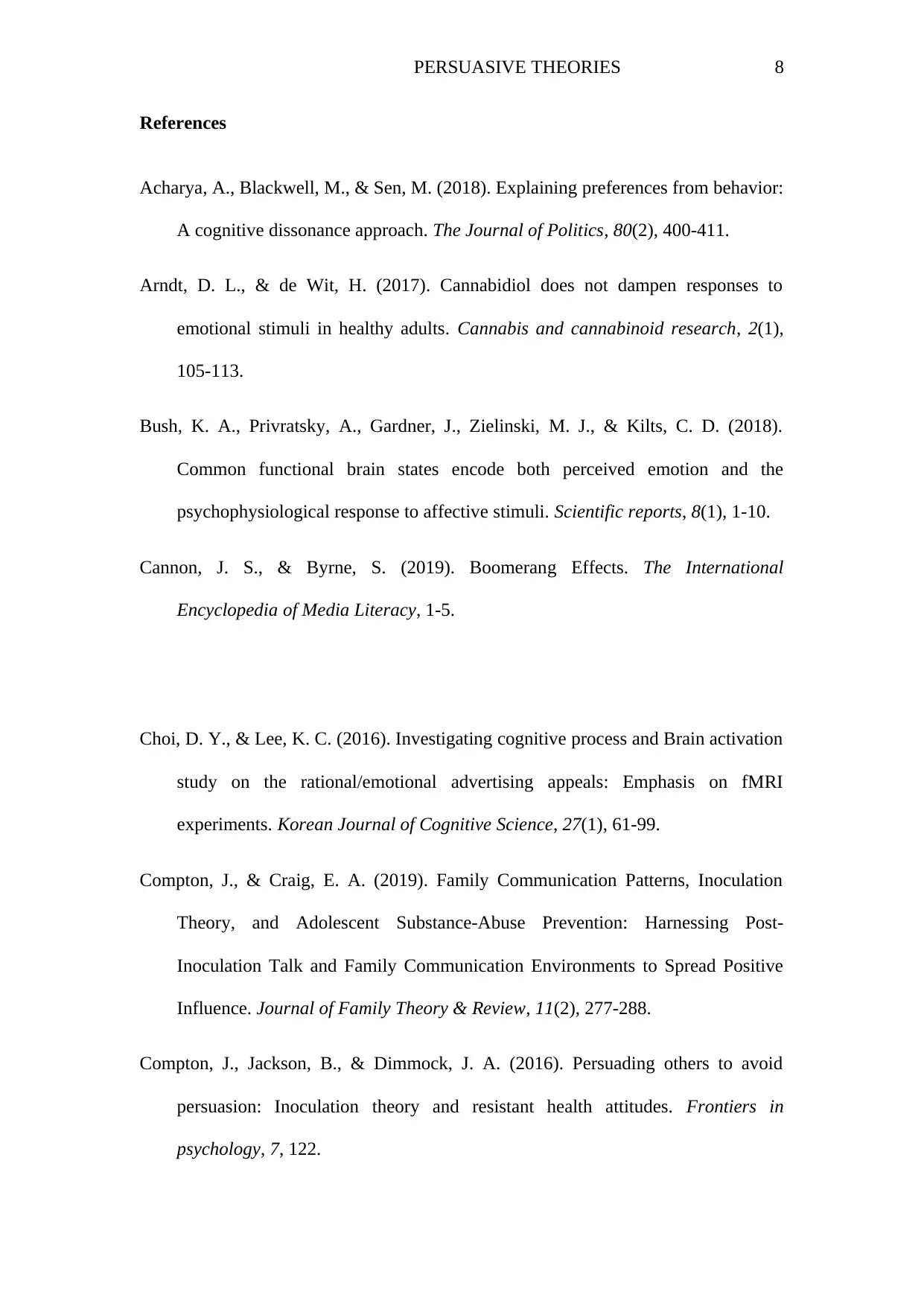
PERSUASIVE THEORIES 8
References
Acharya, A., Blackwell, M., & Sen, M. (2018). Explaining preferences from behavior:
A cognitive dissonance approach. The Journal of Politics, 80(2), 400-411.
Arndt, D. L., & de Wit, H. (2017). Cannabidiol does not dampen responses to
emotional stimuli in healthy adults. Cannabis and cannabinoid research, 2(1),
105-113.
Bush, K. A., Privratsky, A., Gardner, J., Zielinski, M. J., & Kilts, C. D. (2018).
Common functional brain states encode both perceived emotion and the
psychophysiological response to affective stimuli. Scientific reports, 8(1), 1-10.
Cannon, J. S., & Byrne, S. (2019). Boomerang Effects. The International
Encyclopedia of Media Literacy, 1-5.
Choi, D. Y., & Lee, K. C. (2016). Investigating cognitive process and Brain activation
study on the rational/emotional advertising appeals: Emphasis on fMRI
experiments. Korean Journal of Cognitive Science, 27(1), 61-99.
Compton, J., & Craig, E. A. (2019). Family Communication Patterns, Inoculation
Theory, and Adolescent Substance‐Abuse Prevention: Harnessing Post‐
Inoculation Talk and Family Communication Environments to Spread Positive
Influence. Journal of Family Theory & Review, 11(2), 277-288.
Compton, J., Jackson, B., & Dimmock, J. A. (2016). Persuading others to avoid
persuasion: Inoculation theory and resistant health attitudes. Frontiers in
psychology, 7, 122.
References
Acharya, A., Blackwell, M., & Sen, M. (2018). Explaining preferences from behavior:
A cognitive dissonance approach. The Journal of Politics, 80(2), 400-411.
Arndt, D. L., & de Wit, H. (2017). Cannabidiol does not dampen responses to
emotional stimuli in healthy adults. Cannabis and cannabinoid research, 2(1),
105-113.
Bush, K. A., Privratsky, A., Gardner, J., Zielinski, M. J., & Kilts, C. D. (2018).
Common functional brain states encode both perceived emotion and the
psychophysiological response to affective stimuli. Scientific reports, 8(1), 1-10.
Cannon, J. S., & Byrne, S. (2019). Boomerang Effects. The International
Encyclopedia of Media Literacy, 1-5.
Choi, D. Y., & Lee, K. C. (2016). Investigating cognitive process and Brain activation
study on the rational/emotional advertising appeals: Emphasis on fMRI
experiments. Korean Journal of Cognitive Science, 27(1), 61-99.
Compton, J., & Craig, E. A. (2019). Family Communication Patterns, Inoculation
Theory, and Adolescent Substance‐Abuse Prevention: Harnessing Post‐
Inoculation Talk and Family Communication Environments to Spread Positive
Influence. Journal of Family Theory & Review, 11(2), 277-288.
Compton, J., Jackson, B., & Dimmock, J. A. (2016). Persuading others to avoid
persuasion: Inoculation theory and resistant health attitudes. Frontiers in
psychology, 7, 122.
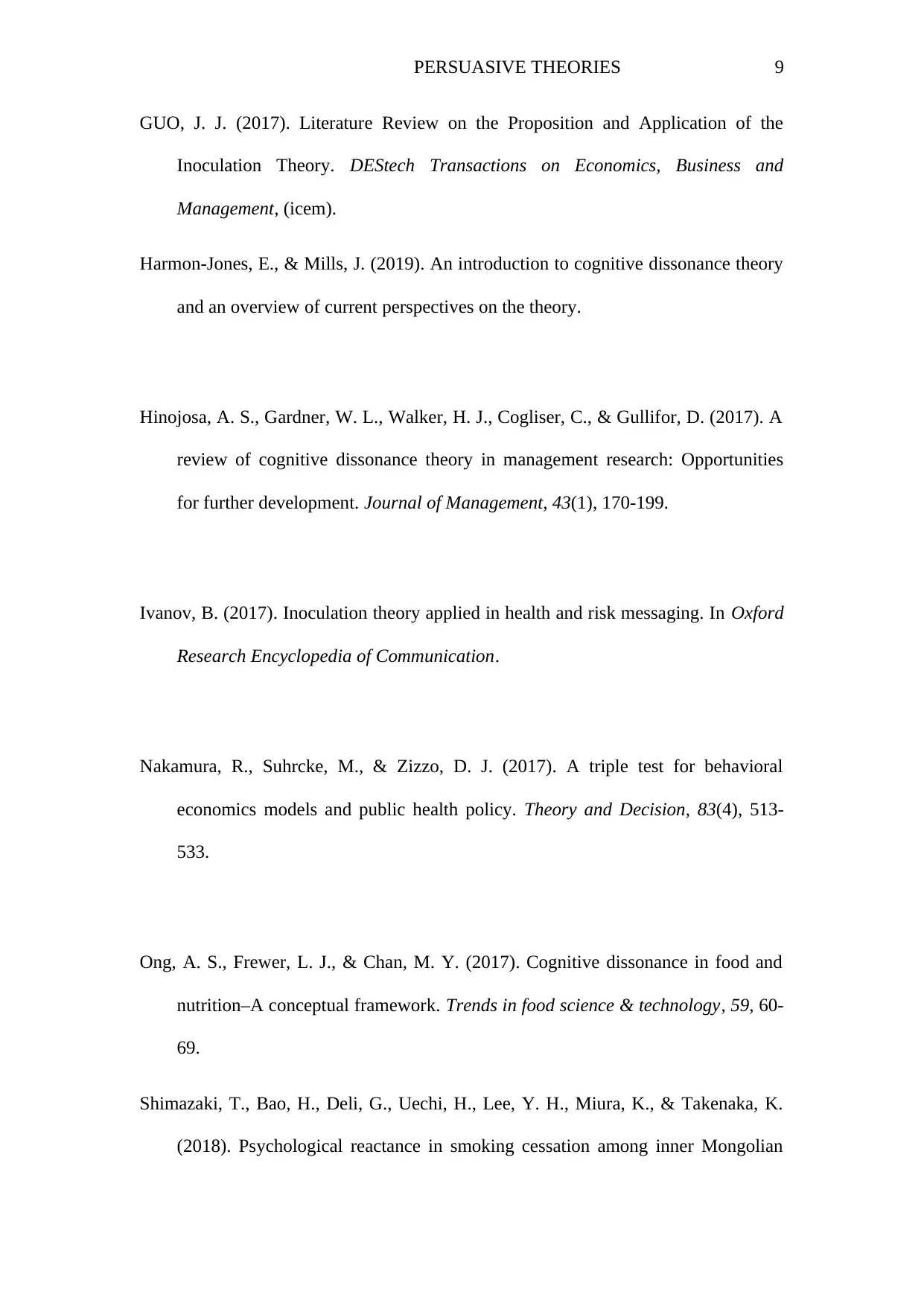
PERSUASIVE THEORIES 9
GUO, J. J. (2017). Literature Review on the Proposition and Application of the
Inoculation Theory. DEStech Transactions on Economics, Business and
Management, (icem).
Harmon-Jones, E., & Mills, J. (2019). An introduction to cognitive dissonance theory
and an overview of current perspectives on the theory.
Hinojosa, A. S., Gardner, W. L., Walker, H. J., Cogliser, C., & Gullifor, D. (2017). A
review of cognitive dissonance theory in management research: Opportunities
for further development. Journal of Management, 43(1), 170-199.
Ivanov, B. (2017). Inoculation theory applied in health and risk messaging. In Oxford
Research Encyclopedia of Communication.
Nakamura, R., Suhrcke, M., & Zizzo, D. J. (2017). A triple test for behavioral
economics models and public health policy. Theory and Decision, 83(4), 513-
533.
Ong, A. S., Frewer, L. J., & Chan, M. Y. (2017). Cognitive dissonance in food and
nutrition–A conceptual framework. Trends in food science & technology, 59, 60-
69.
Shimazaki, T., Bao, H., Deli, G., Uechi, H., Lee, Y. H., Miura, K., & Takenaka, K.
(2018). Psychological reactance in smoking cessation among inner Mongolian
GUO, J. J. (2017). Literature Review on the Proposition and Application of the
Inoculation Theory. DEStech Transactions on Economics, Business and
Management, (icem).
Harmon-Jones, E., & Mills, J. (2019). An introduction to cognitive dissonance theory
and an overview of current perspectives on the theory.
Hinojosa, A. S., Gardner, W. L., Walker, H. J., Cogliser, C., & Gullifor, D. (2017). A
review of cognitive dissonance theory in management research: Opportunities
for further development. Journal of Management, 43(1), 170-199.
Ivanov, B. (2017). Inoculation theory applied in health and risk messaging. In Oxford
Research Encyclopedia of Communication.
Nakamura, R., Suhrcke, M., & Zizzo, D. J. (2017). A triple test for behavioral
economics models and public health policy. Theory and Decision, 83(4), 513-
533.
Ong, A. S., Frewer, L. J., & Chan, M. Y. (2017). Cognitive dissonance in food and
nutrition–A conceptual framework. Trends in food science & technology, 59, 60-
69.
Shimazaki, T., Bao, H., Deli, G., Uechi, H., Lee, Y. H., Miura, K., & Takenaka, K.
(2018). Psychological reactance in smoking cessation among inner Mongolian
⊘ This is a preview!⊘
Do you want full access?
Subscribe today to unlock all pages.

Trusted by 1+ million students worldwide
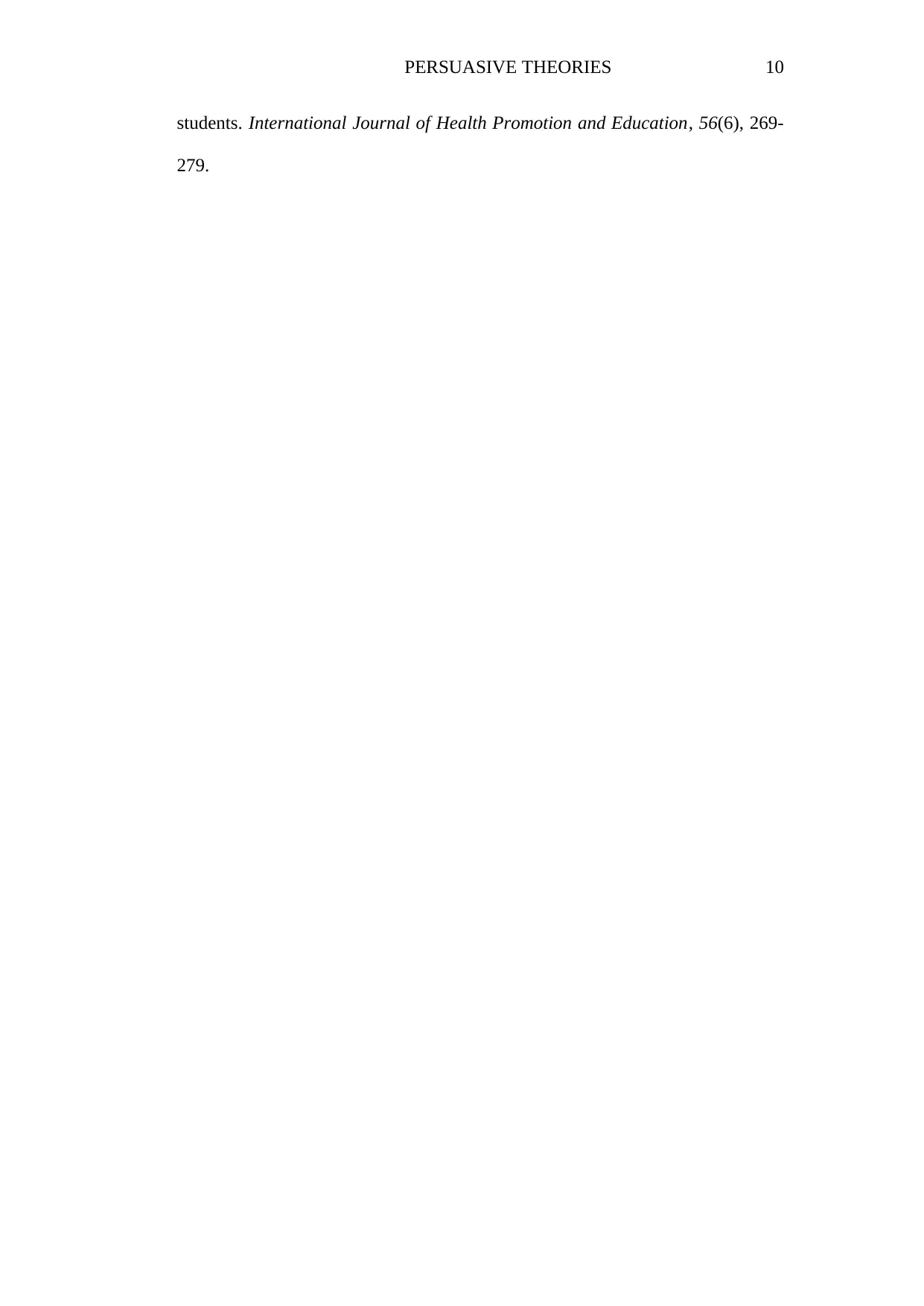
PERSUASIVE THEORIES 10
students. International Journal of Health Promotion and Education, 56(6), 269-
279.
students. International Journal of Health Promotion and Education, 56(6), 269-
279.
1 out of 10
Your All-in-One AI-Powered Toolkit for Academic Success.
+13062052269
info@desklib.com
Available 24*7 on WhatsApp / Email
![[object Object]](/_next/static/media/star-bottom.7253800d.svg)
Unlock your academic potential
Copyright © 2020–2025 A2Z Services. All Rights Reserved. Developed and managed by ZUCOL.
